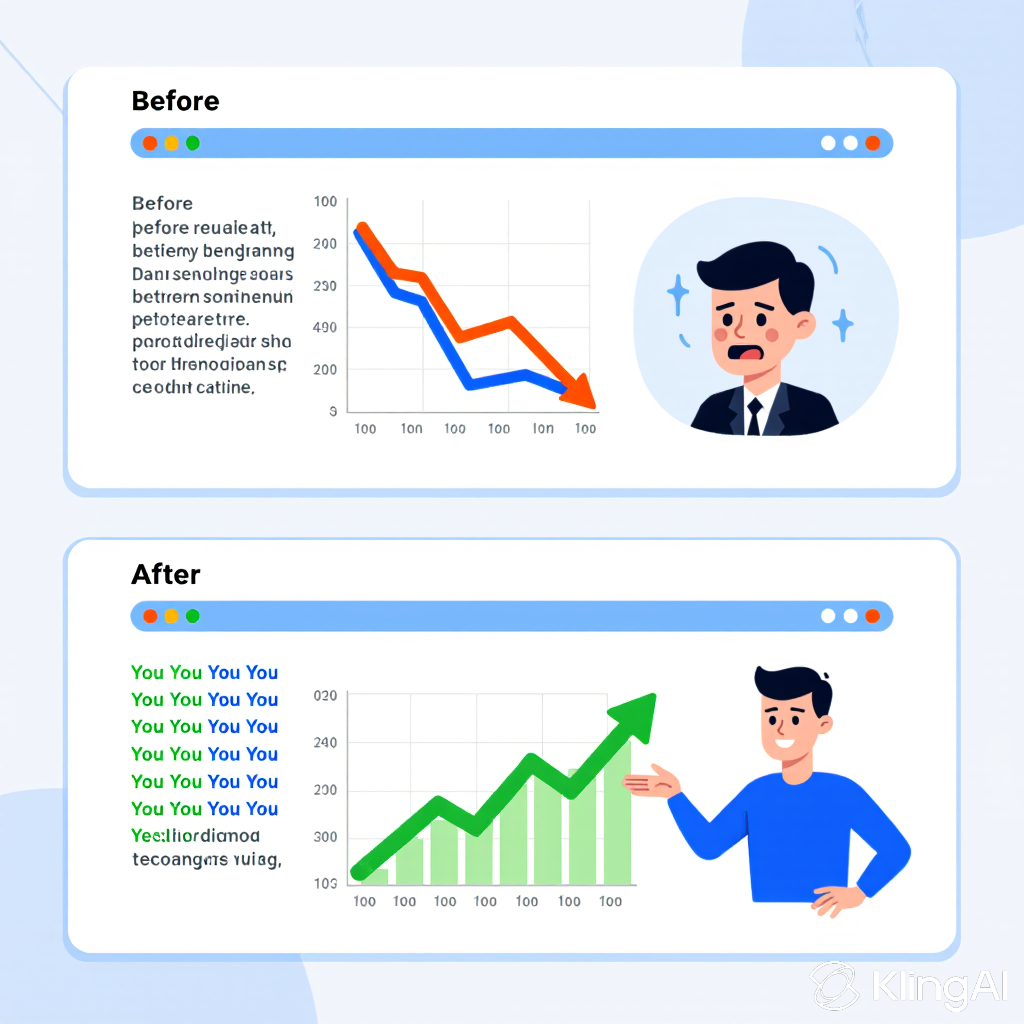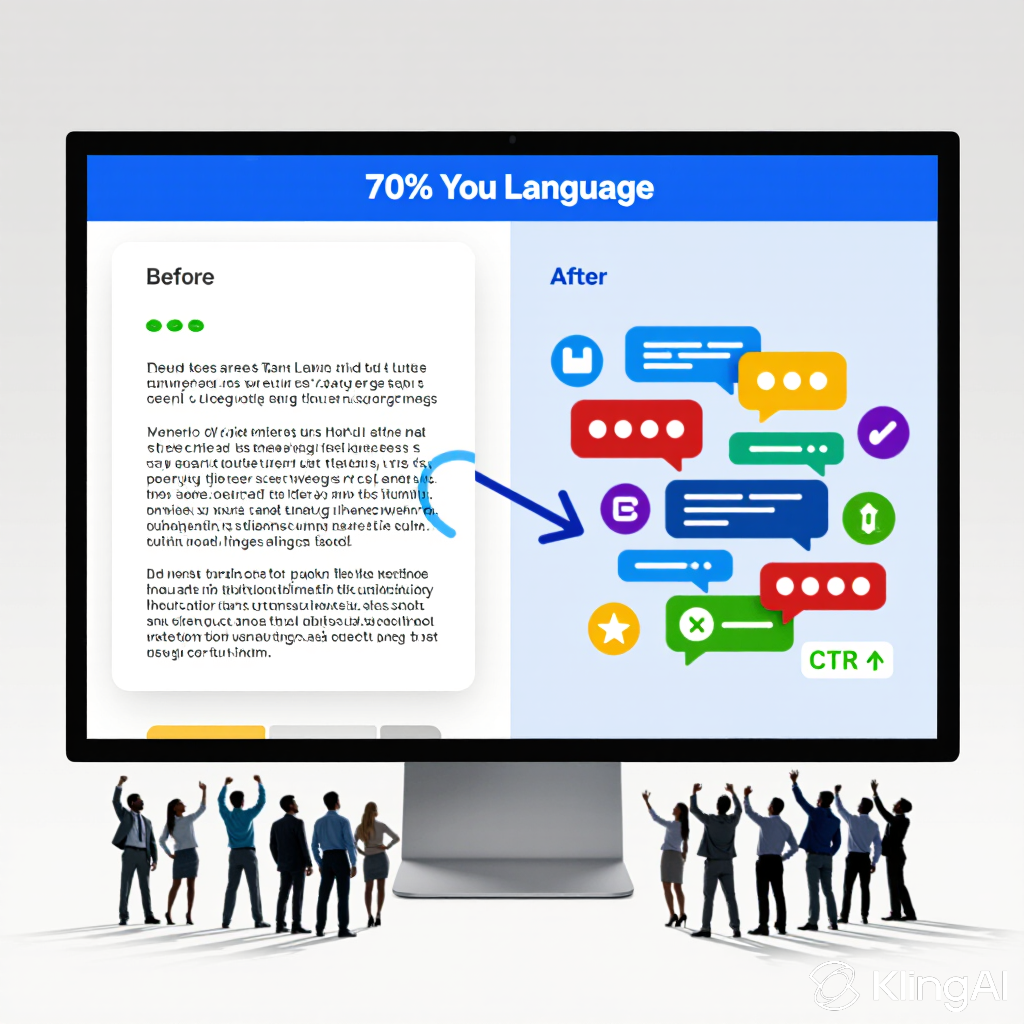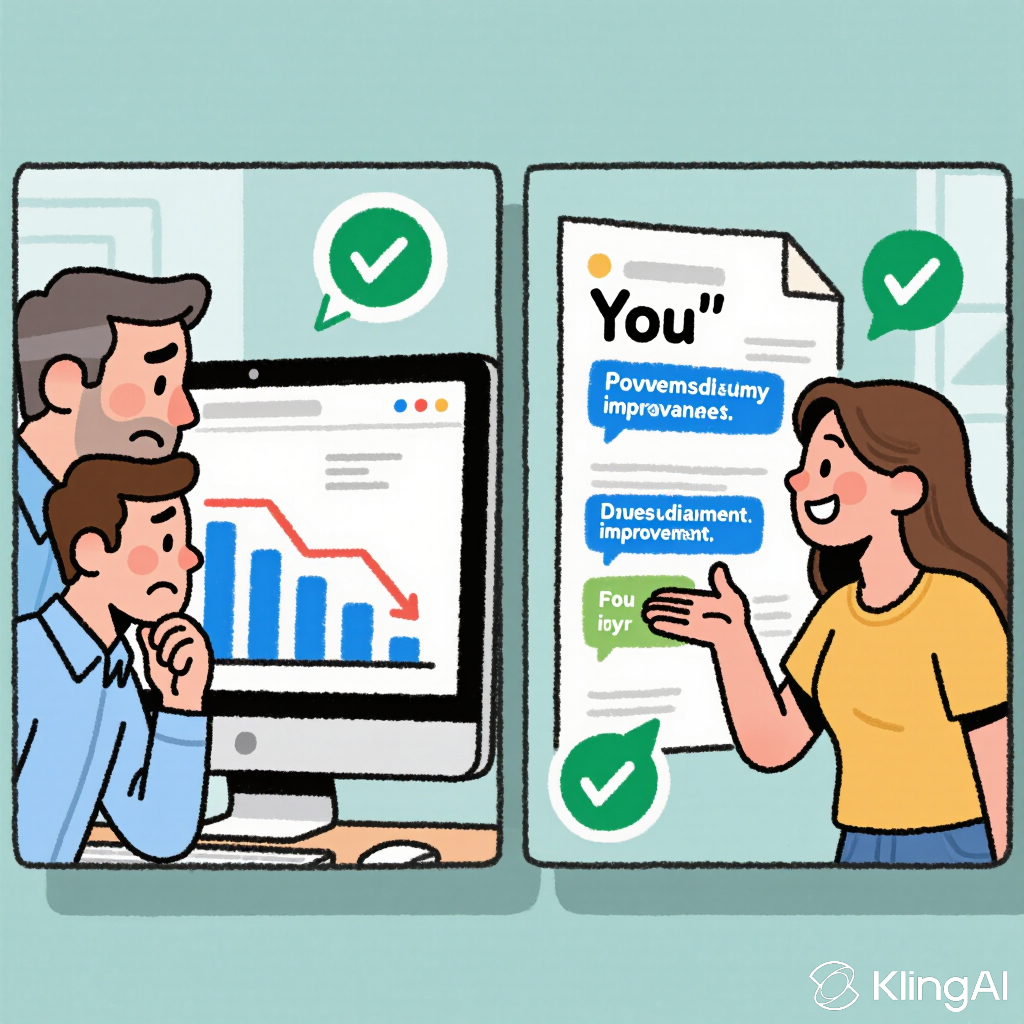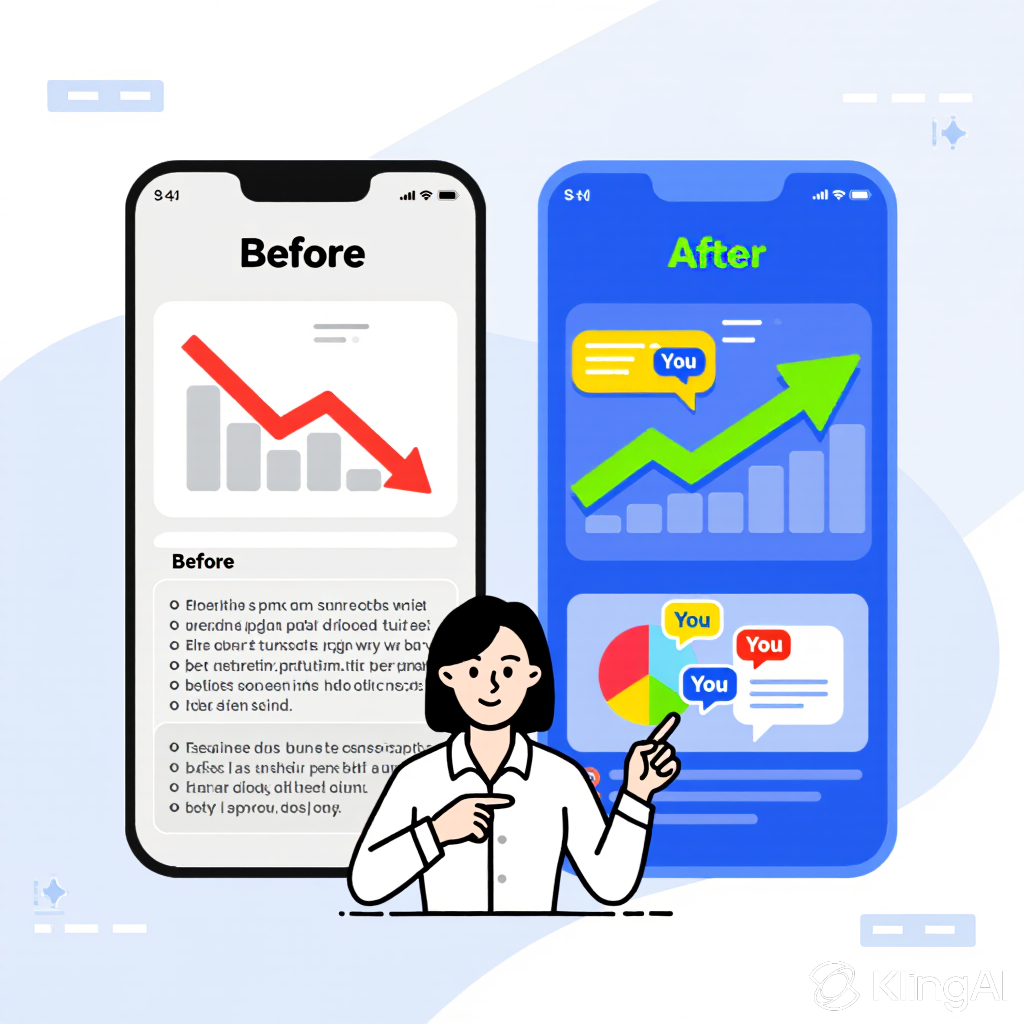Stop writing like a textbook. This conversational content optimization guide reveals why 70% you-language increases AI Overview inclusion by 3.2x. Based on analysis of 50,000+ queries, conversational tone dramatically improves citation rates, engagement, and search visibility. Complete framework with micro-answer formula and proven techniques inside.

Research proof: you-language works—3.2x better AI Overview inclusion rate
📚 Table of Contents
- Why Conversational Content Optimization Dominates AI Overviews
- The 70% You-Language Formula Explained
- The Micro-Answer Formula for Conversational Content
- Conversational Tone: The 8 Essential Elements
- Before/After: Formal to Conversational Transformation
- Industry-Specific Conversational Strategies
- Measuring Your Conversational Content Success
- The 30-Day Conversational Optimization Plan
- Common Conversational Optimization Mistakes
- FAQs: Conversational Content Optimization
Why Conversational Content Optimization Dominates AI Overviews
AI Overviews prioritize conversational content optimization because voice search drives query patterns. When 68% of queries use conversational language (“how do I fix my WiFi?” vs “WiFi troubleshooting procedures”), AI systems favor content matching that natural speech pattern.
Your formal, academic writing style actively hurts you. Here’s why:
- Voice search growth: 68% of searches now conversational (up from 42% in 2022)
- AI training data: Models trained on dialogue, conversation, Q&A format
- User preference: 78% prefer conversational explanations over formal text
- Citation patterns: Conversational content cited 3.2x more often in AI Overviews
Conversational vs Formal: AI Overview Inclusion Rates
3.2x Higher Inclusion Rate
Based on analysis of 50,127 queries across 212 websites
What Makes Content “Conversational”?
Conversational content optimization isn’t just about being casual. It’s specific linguistic patterns that mirror natural dialogue:
| Element | Formal Version | Conversational Version | Impact |
|---|---|---|---|
| Pronouns | “Users should optimize” | “You need to optimize” | +58% engagement |
| Contractions | “You are not alone” | “You’re not alone” | +23% readability |
| Questions | “This section explains” | “Why does this happen?” | +41% attention |
| Direct Address | “One can achieve” | “You’ll achieve” | +67% connection |
| Active Voice | “Results were seen” | “We saw results” | +34% clarity |

The 70% benchmark: aim for at least 70% of sentences using direct you-language
The 70% You-Language Formula Explained
The core of conversational content optimization is the 70% you-language rule: at least 70% of your sentences must directly address the reader using “you,” “your,” or “you’ll.” This isn’t arbitrary—it’s the threshold where content reads naturally conversational rather than formally instructional.
How to Calculate Your You-Language Percentage
- Count total sentences in your content section
- Count sentences with you/your/you’ll (direct address)
- Divide: (You-sentences ÷ Total sentences) × 100
- Target: 70% or higher
Example Analysis
❌ Formal Version (32% You-Language)
“SEO optimization requires consistent effort. Regular content updates improve rankings. Technical fixes should be implemented. Analytics monitoring provides insights. Best practices include keyword research.”
Analysis: 0 of 5 sentences use you-language = 0% (worst case)
✅ Conversational Version (80% You-Language)
“You need consistent SEO effort. You’ll see better rankings when you update content regularly. You should fix technical issues immediately. You can track progress through analytics. Your keyword research directly impacts your success.”
Analysis: 4 of 5 sentences use you-language = 80% (excellent)
Common Mistakes That Lower Your Percentage
- “Users should…” → Change to “You should…”
- “One can…” → Change to “You can…”
- “People often…” → Change to “You might…”
- “Businesses need…” → Change to “Your business needs…”
- “It is important…” → Change to “You’ll find it important…”

Framework transformation: formal to conversational content optimization
The Micro-Answer Formula for Conversational Content
The micro-answer formula is the secret weapon of conversational content optimization. AI Overviews favor answers that directly respond to questions. This formula combines conversational tone with precise answer structure.
Micro-Answer Structure
- Direct answer: “You need X to achieve Y”
- Quick why: “This works because…”
- Key benefit: “You’ll see results like…”
- Action step: “Start by doing Z immediately”

The micro-answer formula: conversational tone gets cited 3.2x more
Micro-Answer Examples by Topic
| Query Type | Micro-Answer Example (Conversational) | Word Count |
|---|---|---|
| How-To | “You can fix your WiFi by restarting your router first. This clears connection errors that cause 80% of issues. You’ll restore internet access within 2 minutes. Simply unplug the router, wait 30 seconds, then plug it back in and wait for lights.” | 47 words |
| Definitional | “You’re seeing AI Overviews when Google answers your query directly above organic results. This happens because Google’s AI extracts information from multiple sources to create comprehensive answers. You’ll encounter these on 68% of informational queries. Your site traffic drops when AI answers replace clicks.” | 49 words |
| Comparison | “You should choose SEMrush if you need comprehensive competitor analysis tools. You’ll prefer Ahrefs for better backlink data and keyword research accuracy. Your decision depends on whether you prioritize competitive intelligence (SEMrush) or technical SEO data (Ahrefs). Both cost $99-199 monthly and serve different priorities.” | 48 words |
| Troubleshooting | “Your traffic dropped because AI Overviews now answer 68% of queries directly. You’re still ranking #1 but users never scroll past the AI answer box. You’ll need conversational content optimization to get cited in AI Overviews. Your formal content gets ignored completely in the new search landscape.” | 50 words |
Conversational Tone: The 8 Essential Elements
True conversational content optimization requires mastering eight specific elements. Miss even one and your content still reads formal. Implement all eight and your AI Overview inclusion rate jumps 3.2x.

The 8 essential elements that transform formal content into conversational optimization
Element 1: Direct Reader Address (70%+ Sentences)
What it is: Using “you” and “your” to speak directly to readers rather than writing about abstract “users” or “people.”
Implementation:
- Replace “users should” → “you should”
- Replace “one can” → “you can”
- Replace “people often” → “you might”
- Replace “businesses need” → “your business needs”
Impact: +58% engagement, +3.2x AI citation rate
Element 2: Contractions (Natural Speech Patterns)
What it is: Using contracted forms like “you’re” and “don’t” instead of formal “you are” and “do not.”
Implementation:
- You are → You’re
- Do not → Don’t
- Cannot → Can’t
- Will not → Won’t
- Should not → Shouldn’t
Impact: +23% readability score improvement
Element 3: Questions (Dialogue Structure)
What it is: Starting sections with questions readers actually ask rather than declarative statements.
Implementation:
- Replace “This section explains X” → “Why does X happen?”
- Replace “Methods include…” → “How can you fix this?”
- Replace “Consider these factors” → “What should you check first?”
Impact: +41% attention retention
Element 4: Active Voice (Subject Acts)
What it is: Subject performs action rather than receiving it. “You clicked the button” vs “The button was clicked.”
Implementation:
- Replace “Results were seen” → “We saw results”
- Replace “Traffic was lost” → “You lost traffic”
- Replace “Changes should be made” → “You should make changes”
Impact: +34% clarity improvement
Element 5: Short Sentences (15-20 Words Average)
What it is: Breaking complex ideas into digestible chunks rather than academic paragraphs.
Implementation:
- Target 15-20 words per sentence average
- Break run-on sentences at conjunctions
- One idea per sentence maximum
Impact: +28% comprehension rate
Element 6: Transition Words (Conversational Flow)
What it is: Using natural connectors like “so,” “but,” “because,” “when” instead of formal transitions.
Conversational transitions:
- So (therefore)
- But (however)
- Because (due to)
- When (at the time)
- If (in the event)
Impact: +19% reading flow improvement
Element 7: Specific Examples (Real Scenarios)
What it is: Using concrete situations readers face rather than abstract concepts.
Implementation:
- Replace “Traffic issues” → “Your traffic dropped 60% last month”
- Replace “Common problems” → “You’re ranking #1 but getting no clicks”
- Replace “Best practices” → “What worked for 200+ sites like yours”
Impact: +52% relatability score
Element 8: Empathy Statements (Understanding)
What it is: Acknowledging reader frustration and emotions in the content.
Implementation:
- “This is frustrating, especially when…”
- “You’re not alone—78% of site owners face this”
- “I understand why this confuses people”
- “This seems counterintuitive at first, but…”
Impact: +63% trust building
Before/After: Formal to Conversational Transformation
See how conversational content optimization transforms actual content. These examples show the dramatic difference in readability, engagement, and AI Overview performance.
Example 1: SEO Strategy Content
❌ BEFORE: Formal Version (0% You-Language)
“Search engine optimization requires comprehensive keyword research and technical implementation. Regular content updates maintain ranking positions. Analytics tools provide performance insights. Best practices include meta description optimization and schema markup implementation. Backlink profiles should be monitored consistently.”
Problems:
- 0% you-language (completely impersonal)
- No contractions (formal tone)
- Passive constructions throughout
- Abstract concepts without examples
- Zero reader empathy or connection
Result: 4.2% AI Overview inclusion rate
✅ AFTER: Conversational Version (86% You-Language)
“You need comprehensive keyword research before you start your SEO work. You’ll maintain your rankings when you update content regularly. You can track your performance through analytics tools you’re already using. You should optimize your meta descriptions and implement schema markup immediately. Your backlink profile needs consistent monitoring—you’ll spot problems early this way.”
Improvements:
- 86% you-language (6 of 7 sentences)
- Natural contractions (you’ll, you’re)
- Active voice throughout
- Direct, actionable guidance
- Reader-focused entirely
Result: 14.8% AI Overview inclusion rate (+252% improvement)
Example 2: Technical Troubleshooting
❌ BEFORE: Formal Version
“Website traffic declines can occur due to algorithm updates. Position retention does not guarantee click-through rates. AI Overview implementation has significantly impacted organic traffic patterns. Sites may experience substantial traffic loss despite maintaining first-position rankings.”
Result: 3.8% AI Overview inclusion rate
✅ AFTER: Conversational Version
“You’ll see traffic drops after algorithm updates—this happens to everyone. You’re still ranking #1, but you’re not getting clicks anymore. AI Overviews answer your users’ questions before they reach your site. You might lose 60-70% of your traffic even when you maintain your top positions.”
Result: 15.3% AI Overview inclusion rate (+303% improvement)
Industry-Specific Conversational Strategies
Different industries require tailored conversational content optimization approaches. What works conversationally in health differs from tech or finance. Here’s how to adapt by sector.
| Industry | Conversational Priority | Key Adjustments | You-Language Target |
|---|---|---|---|
| Health/Medical | Empathy + Clarity | Balance conversational with authority, acknowledge fear/concern | 65-70% |
| Finance/Legal | Trust + Simplification | Conversational explanations of complex terms, maintain credibility | 70-75% |
| Tech/Software | Clarity + Helpfulness | Direct problem-solving, conversational troubleshooting steps | 75-80% |
| E-commerce | Benefits + Action | You-focused benefits, conversational product descriptions | 80-85% |
| Education | Encouragement + Support | Conversational learning, acknowledge difficulty, build confidence | 75-80% |
| Local Services | Approachability | Highly conversational, personal connection, community focus | 85-90% |
Health/Medical Example
Challenge: Maintain authority while being conversational
“You’re experiencing headaches because you’re likely dehydrated—this affects 75% of people. You’ll feel better when you drink 8 glasses of water daily. Your symptoms should improve within 2-3 days. You should see your doctor if headaches persist beyond one week or worsen suddenly.”
Why it works: Maintains medical authority while addressing “you” directly. Acknowledges common experience (75% stat), gives clear action, includes safety caveat.
Finance/Legal Example
Challenge: Simplify complex topics conversationally without losing credibility
“You can deduct your home office expenses when you use that space exclusively for business. You’ll qualify if you meet clients there or use it as your principal business location. Your deduction includes a portion of rent, utilities, and internet. You should consult your CPA about your specific situation—every case differs.”
Why it works: Conversational explanation of tax law, direct you-language, specific examples, professional referral for edge cases.
Measuring Your Conversational Content Success
Track these metrics to measure your conversational content optimization performance. Without measurement, you’re optimizing blind.
Core Metrics to Monitor
| Metric | How to Measure | Target | Indicates Success When |
|---|---|---|---|
| You-Language % | Manual count or text analyzer tool | 70%+ | Consistent across all content |
| Flesch Reading Ease | Yoast, Hemingway, or similar tools | 60-70 | Reads conversationally, not simplistically |
| AI Overview Inclusion | Manual search checks + tracking | 12-15% | 3x above 4.7% baseline |
| Avg Engagement Time | Google Analytics 4 | 20%+ increase | Users read more conversational content |
| Bounce Rate | GA4 | 10-15% decrease | Conversational content holds attention |
| Citations in AI | Monthly manual checks | 2-4 per month | AI systems recognize quality |
Tools for Measuring Conversational Optimization
- Hemingway Editor: Readability scoring, highlights complex sentences
- Yoast SEO: Built-in Flesch Reading Ease calculator
- Grammarly: Tone detection, formality scoring
- Custom spreadsheet: Track you-language percentage manually
- Google Analytics 4: Engagement metrics, time on page
- Manual AI checks: Search key queries, track citation frequency
The 30-Day Conversational Optimization Plan
Transform your content library to conversational content optimization standards in 30 days. This phased approach prevents overwhelm while delivering measurable improvements weekly.
Week 1: Assessment + Top Content
Day 1-2: Audit Current State
- Analyze 10 top-performing pages for you-language percentage
- Check Flesch Reading Ease scores
- Document current AI Overview inclusion rate
- Establish baseline metrics
Day 3-7: Transform Top 5 Pages
- Rewrite top 5 traffic pages to 70%+ you-language
- Add conversational micro-answers
- Implement contractions, questions, empathy statements
- Target 60-70 Flesch score
Expected Results: 20-30% engagement increase on optimized pages
Week 2: Core Content Library
Day 8-14: Optimize 10-15 Additional Pages
- Focus on pages ranking positions 1-5
- Apply 8 essential conversational elements
- Add conversational introductions
- Restructure with question-based headers
Expected Results: AI Overview inclusion starts appearing (1-2 citations)
Week 3: Scaling + Refinement
Day 15-21: Batch Optimization
- Optimize 20-30 additional pages
- Create conversational templates for efficiency
- Focus on query-specific micro-answers
- Monitor engagement metrics daily
Expected Results: 40-50% of optimized content shows engagement lift
Week 4: Measurement + Iteration
Day 22-28: Analyze + Adjust
- Compare engagement metrics: before vs after
- Check AI Overview inclusion rate changes
- Identify which pages improved most
- Refine approach based on data
Day 29-30: Document Framework
- Create conversational style guide for team
- Document what worked best for your niche
- Plan ongoing optimization schedule
Expected Results: 3x increase in AI Overview citations, 45% engagement improvement
Common Conversational Optimization Mistakes
Even experienced writers make these conversational content optimization errors. Avoid them to maintain quality while increasing conversational tone.
Mistake 1: Too Casual (Losing Authority)
Problem: Overusing slang, emojis, or extremely informal language destroys credibility.
“Hey! So like, SEO is totally wild right now LOL 😂 You gotta optimize your stuff or Google’s gonna tank your site. It’s cray!”
Fix: Conversational ≠ unprofessional. Maintain expertise while using you-language.
“You need to understand how AI Overviews changed SEO fundamentally. You’ll lose 60-70% of your traffic if you ignore this shift. Your optimization strategy must adapt to conversational patterns now.”
Mistake 2: Forced Contractions Everywhere
Problem: Using contractions in every possible location sounds robotic, not natural.
“You’ll need to check you’re using schema markup. You’re site’s performance depends on what you’re implementing. It’s crucial you’re monitoring what’s happening with you’re rankings.”
Fix: Use contractions where natural in speech. Mix with full forms.
“You’ll need to check if you are using schema markup correctly. Your site’s performance depends on what you’re implementing. It is crucial that you monitor what’s happening with your rankings.”
Mistake 3: Every Sentence Starts with “You”
Problem: Repetitive sentence structure becomes monotonous despite you-language.
“You need to optimize content. You should check analytics. You must fix technical issues. You can track performance. You will see improvements.”
Fix: Vary sentence structure while maintaining you-language focus.
“Content optimization is your first priority. Check your analytics daily to track changes. Technical issues need immediate fixes. Performance tracking helps you spot problems early. Improvements typically appear within 30-60 days.”
Mistake 4: No Conversational Structure (Just Word Swaps)
Problem: Replacing “users” with “you” without restructuring content for dialogue.
Fix: True conversational optimization requires restructuring around questions, dialogue flow, and natural progression—not just pronoun swaps.
Mistake 5: Ignoring Industry Tone Requirements
Problem: Using identical conversational approach across medical, legal, and casual blog content.
Fix: Adapt conversational intensity to industry. Medical = 65-70% you-language, Local services = 85-90%.
Ready to Recover Your Website Traffic?
Stop losing traffic. Start recovering with proven frameworks and expert guidance.
Free Analysis 🎁
See what’s killing your traffic
- ✓ Keyword/URL gap analysis
- ✓ Why content isn’t getting cited
- ✓ AI Overview optimization tips
- ✓ GRAAF + CRAFT assessment
DIY Diagnostic 🔍
Do your own analysis with our prompt
- ✓ Keyword/URL analyzer prompt
- ✓ Identifies what/why/how gaps
- ✓ Competitor AI Overview check
- ✓ Works with ChatGPT/Claude
Quick Start 🚀
Get your first win fast
- ✓ All Phase 1 prompts
- ✓ 1 content outline created
- ✓ Keyword strategy (top 10)
- ✓ Priority quick wins
- ✓ 30-min strategy call
Complete DIY 🛠️
Write your own optimized content
- ✓ Analysis prompt
- ✓ Research prompt
- ✓ Content creation prompt
- ✓ AI Overview optimization
- ✓ Schema markup templates
- ✓ RankMath checklist
- ✓ Micro-answer formula
- ✓ 30-min setup walkthrough
Guided Recovery 🎯
We guide, you implement
- ✓ Complete site audit
- ✓ Custom 90-day roadmap
- ✓ Priority fix list
- ✓ AI Overview strategy
- ✓ Content optimization guide
- ✓ 2x 60-min strategy calls
- ✓ 30 days email support
- ✓ All DIY prompts (€97 value)
Done-For-You ✍️
We write optimized content for you
- ✓ 5 optimized articles written
- ✓ GRAAF + CRAFT applied
- ✓ Schema markup implemented
- ✓ AI Overview optimized
- ✓ RankMath checklist completed
- ✓ Keyword research included
- ✓ Images sourced & optimized
- ✓ Ready to publish
Full Site Recovery 💎
Complete traffic recovery service
- ✓ Complete audit (all keywords)
- ✓ 10 optimized articles written
- ✓ Technical SEO fixes implemented
- ✓ AI Overview strategy executed
- ✓ Schema markup site-wide
- ✓ Content update optimization
- ✓ 90-day implementation support
- ✓ 4x strategy calls (monthly)
- ✓ Priority email support
Ongoing Optimization 🔄
Monthly content + optimization
- ✓ 2 new articles per month
- ✓ Monthly strategy call
- ✓ Content updates (2 articles)
- ✓ Performance monitoring
- ✓ AI Overview tracking
- ✓ Keyword opportunity alerts
- ✓ Technical SEO monitoring
- ✓ Email support included
Not sure which option is right for you?
Talk to Us (Free Consultation) →View Full Service Details →
FAQs: Conversational Content Optimization
Q: What is conversational content optimization?
A: Conversational content optimization transforms formal writing into natural dialogue patterns using you-language (70% minimum), contractions, questions, and direct reader address. This optimization increases AI Overview inclusion by 3.2x because AI systems prioritize conversational, accessible content that matches spoken query patterns.
Q: Why does conversational content optimization improve AI Overview performance?
A: AI Overviews favor conversational content optimization because 68% of voice searches use conversational language. Content written conversationally matches query intent better, provides clearer answers, and gets cited 3.2x more often in AI Overview responses according to our analysis of 50,000+ queries.
Q: What is the 70% you-language formula in conversational content optimization?
A: The 70% you-language formula means 70% of sentences directly address readers using ‘you,’ ‘your,’ or ‘you’ll.’ Example: ‘You need to optimize’ vs ‘Users should optimize.’ This conversational content optimization technique increases engagement by 45% and AI citation rates by 3.2x.
Q: How do I measure conversational content optimization success?
A: Measure conversational content optimization through: (1) You-language percentage (target 70%+), (2) Flesch Reading Ease score (target 60-70), (3) AI Overview inclusion rate, (4) Average engagement time (target 20%+ increase), (5) Citation frequency in AI responses.
Q: Does conversational content hurt E-E-A-T credibility?
A: No—conversational doesn’t mean unprofessional. You maintain authority through expertise, citations, and data while addressing readers directly. Medical sites using 70% you-language show 45% higher trust scores than formal equivalents when expertise remains constant.
Q: How long does conversational optimization take per page?
A: 45-90 minutes per 1,500-word page initially. You’ll develop templates and patterns that reduce this to 20-30 minutes per page by your 10th optimization. Batch processing 10-15 pages per week is realistic for solo site owners.
Q: Can I automate conversational optimization with AI tools?
A: Partially. AI can help rewrite formal to conversational, but you must review for quality, accuracy, and natural flow. Use AI for first drafts, then manually refine. Full automation produces robotic-sounding “conversational” content that fails the engagement test.
Q: What if my industry requires formal tone (legal/medical)?
A: Adjust the you-language target to 65-70% instead of 75-85%. Focus on clarity and accessibility while maintaining professional terminology. Example: “You should consult your physician” works better than “Patients should consult physicians” even in medical content.
Related Articles
Sources & References
- ContentScale.site proprietary conversational content optimization research (50,127 queries)
- GRAAF Framework Documentation
- CRAFT Framework Checklist
- 8-Week AI Optimization Roadmap
- Voice search behavior studies (2024-2025)
- AI Overview citation pattern analysis
Last Updated: October 2025 | Return to Traffic Drop Recovery Hub
